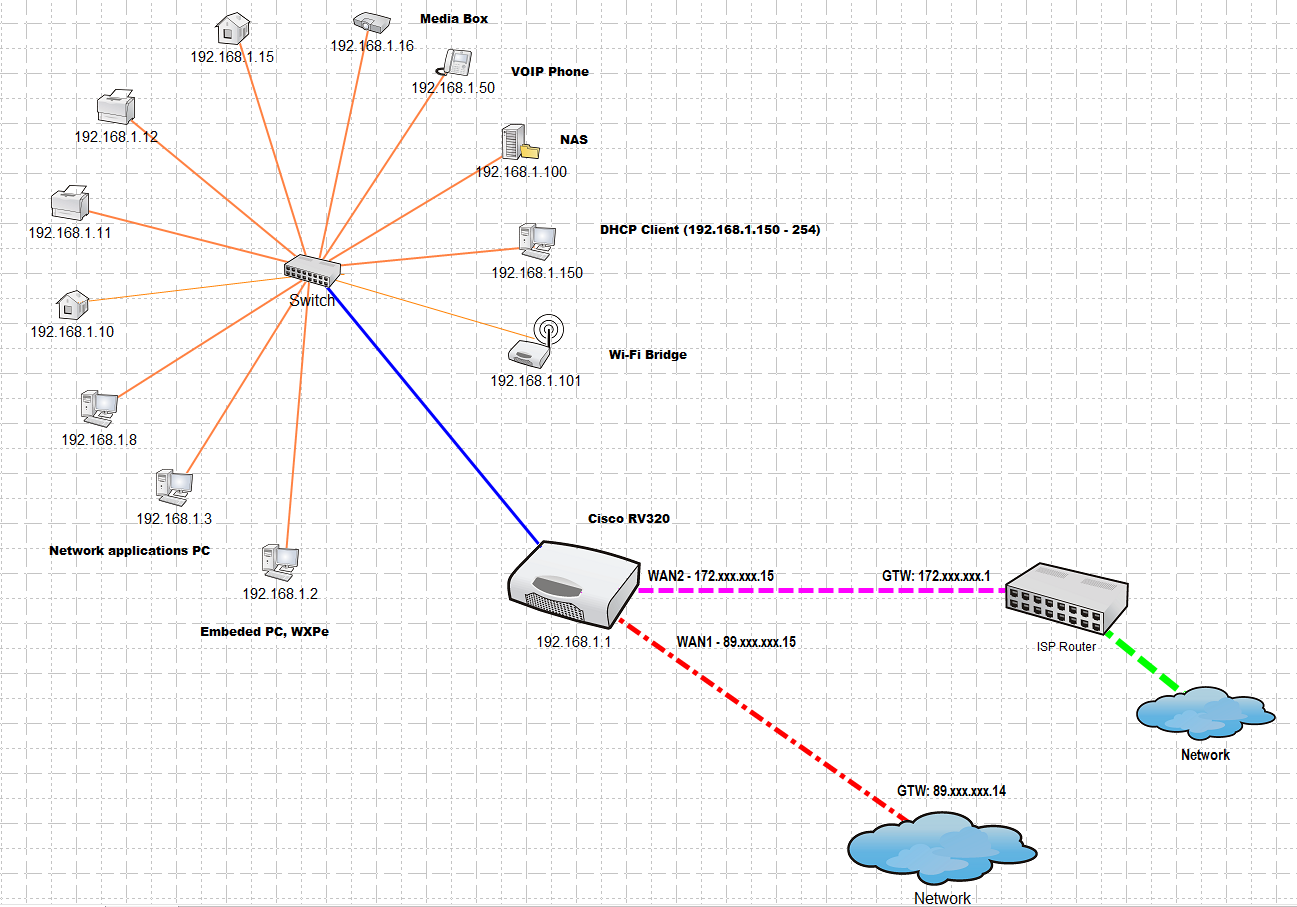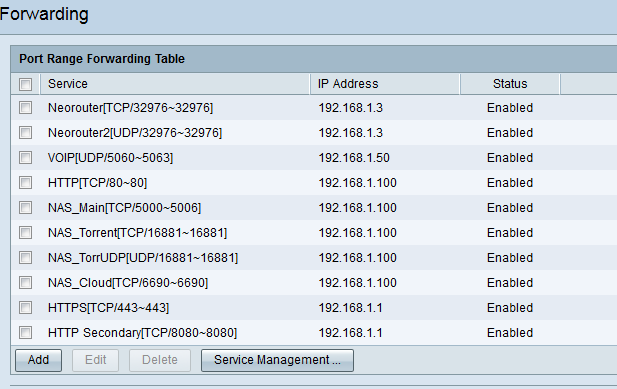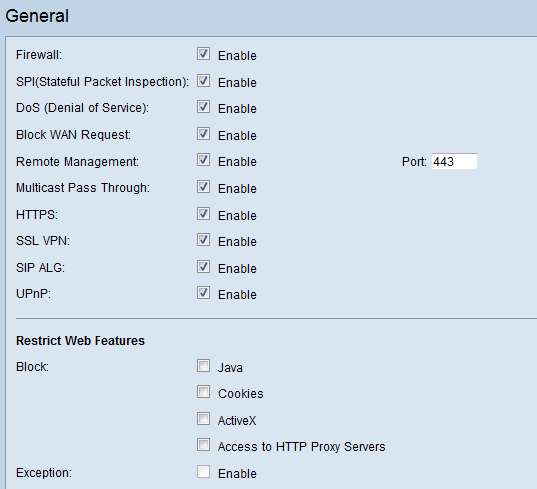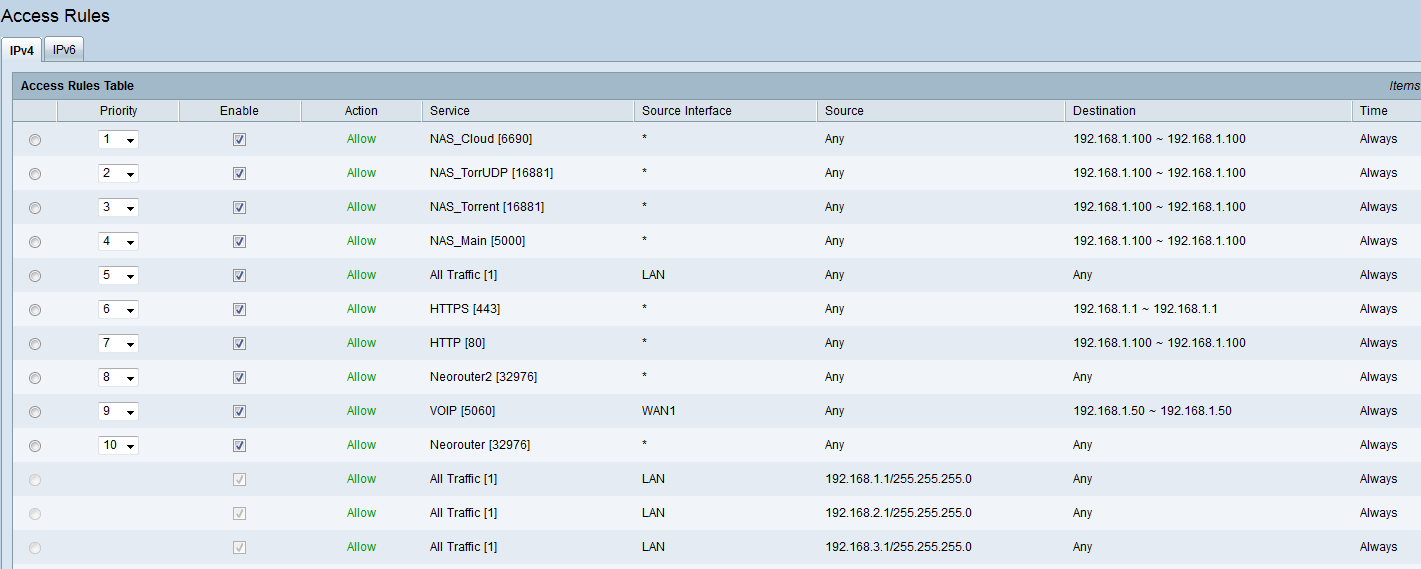- Subscribe to RSS Feed
- Mark Topic as New
- Mark Topic as Read
- Float this Topic for Current User
- Bookmark
- Subscribe
- Mute
- Printer Friendly Page
- Mark as New
- Bookmark
- Subscribe
- Mute
- Subscribe to RSS Feed
- Permalink
- Report Inappropriate Content
02-22-2014 03:45 AM
I use RV320 router shortly and I am trying to set all services I need. This router uses 2 WANs, one with public IP, second with provider's network IP address. All the traffic from LAN to internet goes over non-public (WAN2, provider's IP) and public IP (WAN1) is intended for remote access to local network, several services and VPN.
I have added a DNS record in the domain administration so anyone in internet typing "remote.mydomain.xy" is redirected to WAN1 IP address where login page of router or NAS is shown.
When I type "remote.mydomain.xy" within LAN, the request is timed out.
As I found, this feature is called hairpinning. I tried to google any solution, but all of them are more or less far from my router setting.
The same goes for other services. They are accessible from outside the network but not responding within LAN. I have to set manually the local IP of device with running service and when leaving the office, I have to change back to public IP or remote.mydomain.xy
Is there any easy solution how to enable hairpin function on this router?
I tried to set it in Firewall's access rules, but without success. I think it has to have something in common with Firewall setting as the hairpin seems to work when firewall is disabled.
Solved! Go to Solution.
- Labels:
-
Small Business Routers
Accepted Solutions
- Mark as New
- Bookmark
- Subscribe
- Mute
- Subscribe to RSS Feed
- Permalink
- Report Inappropriate Content
02-25-2014 10:32 AM
Miroslav,
Delete the Forwarding and Access Rules that point 443 and 8080 to 192.168.1.1. Port forwarding is not needed for Remote Management and the firewall cannot forward traffic to the WAN port, only the LAN. Nothing should ever be forwarded to 192.168.1.1.
If the hairpinning is still working intermittently after deleting those rules, back up the RV320 configuration and reset it to factory defaults. Connect it to WAN 1 and enable Remote Management on 433. Try to reach the web UI at https://
- Marty
- Mark as New
- Bookmark
- Subscribe
- Mute
- Subscribe to RSS Feed
- Permalink
- Report Inappropriate Content
02-22-2014 07:52 PM
I think I am understanding what you are saying. You want local access to WAN1 via the domain name remote.mydomain.xy.
There's a couple of different ways to do this, but first I'm curious as to how did you assigned the domain name remote.mydomain.xy to the WAN1 public IP?
Huntsville's Premiere Car and Bike e-magazine: www.huntsvillecarscene.com
- Mark as New
- Bookmark
- Subscribe
- Mute
- Subscribe to RSS Feed
- Permalink
- Report Inappropriate Content
02-23-2014 12:56 AM
Yes exactly, I want this function. It is the same situation when I type the public IP address of WAN1 within LAN.
It does not response to ping sometimes also. Which is even more strange.
To assign IP to certain DNS is pretty simple (at least in my case).
I have a domain (mydomain) and it is registered at domain administrator. The hosting is provided by diferrent company that is pretty cheaper than domain administrator (who offers hosting too) and offers also, in my opinion, simpler settings.
You can also edit domain's DNS, so I added the prefix "remote" to domain name and defined IP address of WAN1, type A for this record.
That's it.
I have played with DynDNS and other DNS servers and tried to establish the same, but all these services are paid and then the idea with hosting provider crossed my mind.
- Mark as New
- Bookmark
- Subscribe
- Mute
- Subscribe to RSS Feed
- Permalink
- Report Inappropriate Content
02-24-2014 09:30 AM
Okay, so I think I get it. You've used a subdomain off your main domain to point to WAN1's IP address, correct?
Try this experiment--use the wan IP address from the lan and see if that works. I just tried it on one of my smb routers (non-cisco) and it did allow me to get into the remote access via the wan IP. If this works, then it's something with the domain setup. Otherwise, it may be a limitation on the rv320 to not allow hairpinning (possibly to avoid a network loop).
Huntsville's Premiere Car and Bike e-magazine: www.huntsvillecarscene.com
- Mark as New
- Bookmark
- Subscribe
- Mute
- Subscribe to RSS Feed
- Permalink
- Report Inappropriate Content
02-24-2014 12:48 PM
Samir,
it is router's issue. I have tested it with the public IP many times, even before I set the subdomain pointing at my public IP. This is not just the case of RV320, I would guess that all the Cisco routers do not allow hairpinning by default as you can find by googling cisco + hairpinning.
It is possible to enable the feature on Cisco ASA Firewalls, where INTRA-INTERFACE command is available but the firewall in RV320 lacks any advance settings.
I have found this:
https://supportforums.cisco.com/thread/2151099
quite old thread
I have also tried to set the internal DNS, which works fine for remote.mydomain.xy -> 192.168.1.1, but it does not work for "public IP" to "local IP" of course.
The funny thing is, I have bound all LAN IPs to WAN2 (ISP IP) and want to get to public IP on WAN1, so it definitely goes out the router over the second cable and should return over the first cable ( or I think this works this way)
And once again. This issue is probably Firewall related, as it works the way I want when Firewall is disabled, which is not desired and I am looking for the way how to go round this obstacle.
Well, I would say, Cisco probably does not allow hairpinning by default in order to block network loops but IMHO they should let their customers choose.
- Mark as New
- Bookmark
- Subscribe
- Mute
- Subscribe to RSS Feed
- Permalink
- Report Inappropriate Content
02-24-2014 02:01 PM
Ah, I see you've done quite a bit of testing. The only way I think you could 'force' it would be to use a static route that will designate any lan traffic for the wan IP to go to the default gateway instead. Or, worse case, you can have two different subdomains--one remote.domain.xy and remote2.domain.xy, one for the WAN IP and one for the LAN IP.
Huntsville's Premiere Car and Bike e-magazine: www.huntsvillecarscene.com
- Mark as New
- Bookmark
- Subscribe
- Mute
- Subscribe to RSS Feed
- Permalink
- Report Inappropriate Content
02-24-2014 02:38 PM
Miroslav,
If the RV320 does not allow hairpinning, then it is the only Small Business router that I know of that does not. I have an RV220W at home and it allows hairpinning. I have also used the RV180W, WRV210, WRV200 and recently ISA550W. All of them allow hairpinning by default except for the ISA550W. In that router an Advanced NAT Rule is required and then it works. From what I've read so far it doesn't sound like what you are doing is actually hairpinning or NAT loopback. Hairpinning would be where the outbound traffic used WAN 1 and was directed back to the LAN server. I am not clear about what is connected to WAN 2.
"This router uses 2 WANs, one with public IP, second with provider's network IP address. All the traffic from LAN to internet goes over non-public (WAN2, provider's IP) and public IP (WAN1) is intended for remote access to local network, several services and VPN."
What do you mean by "provider's network IP address" and "non-public (WAN2, provider's IP)"?
Is that a second ISP or the same?
Is there a router between the RV320 and ISP on WAN 2?
If you unplug WAN 2 from the RV320, all outbound traffic should fail over to WAN 1. Try that and see if hairpinning works, as that would be true hairpinning.
Please also answer my questions so I can better understand your configuration. A simple drawing in Paint is also useful.
- Marty
- Mark as New
- Bookmark
- Subscribe
- Mute
- Subscribe to RSS Feed
- Permalink
- Report Inappropriate Content
02-25-2014 01:43 AM

- Mark as New
- Bookmark
- Subscribe
- Mute
- Subscribe to RSS Feed
- Permalink
- Report Inappropriate Content
02-25-2014 02:35 AM
Hello Marty,
thanks for words of hope.
I have found, you are right about hairpinning in the terms you described.
The problem is probably somewhere else.
I am sorry for any confusion by designating WANs.
I've got one local ISP, which connects our building by fiber optic cable and we are therefore a part of their town network.
They have reliable connection, so I do not need a backup line as I do not run any crucial application where one hour off-line means catastrophy.
That is why, RV320 is in load balancing mode
.
I wanted 2 WAN connections in order to be visible from internet for certain applications where tight rules are set on the other hand; I do not want to leave too many traces, because not just myself uses our LAN.
Also, I suppose, ISP maintains his network more secure and attacks proof.
router's WANs are configured to load balancing
I have bound:
LAN's IPs range 192.168.1.4 - 254 to WAN2
LAN's IPs range 192.168.1.1-3 to WAN1
where:
WAN1 is configured for public IP - 89.xxx.xxx.15 and GTW is 89.xxx.xxx.14
WAN2 is configured with local ISP's IP - 172.xxx.xxx.15 and GTW is 172.xxx.xxx.1
Both WANs have the same DNS servers, primary: 89.xxx.aaa.2, secondary: 89.xxx.bbb.2, as both are in one provider's network.
I have absolutely no idea, how it is connected within their network, how many routers etc is on the way.
Their town network has around 5000 clients.
When I disconnect WAN1 - all the LAN to WAN traffic is automatically redirected to WAN2, and I see the ISP's IP when trying .
When I disconnect WAN2 - all the LAN to WAN traffic is automatically redirected to WAN1, and I see my public IP ( whatismyip.com).
When both WANs are connected, it follows the rules set in binding table. I see ISP's IP when connecting from device 192.168.1.4 upward and my public IP when connecting from device 192.168.1.2-3
When I ping my public IP while WAN1 is disconnected, I get message from GTW that IP is not reachable.
Doing the same when WAN2 is disconnected, I get 100% return.
The strange thing is, ping does not respond the same all the time
.
I tried it yesterday, one of four packets was lost, another try, 100% successful.
I tried it today and received "time out".
As the router's WEB UI is on port 443, I tried to type https://publicIP and WEB UI page appeared.
Since then, ping works fine <1ms
When I type my publicIP on my mobile, while Wi-Fi is off (connected thru cell network) I get router's WEB UI through https:, when typing publicIP through http: I get NAS'es Web UI. This is done by port forwarding, as you can see on the pictures bellow.
So it works fine outside the network
Partially or not at all from inside the network .
I suspect, port forwarding and firewall's access rules have to be tuned up, but I have no idea how.
I believe that all necessary is opened and forwarded.
Mirek
- Mark as New
- Bookmark
- Subscribe
- Mute
- Subscribe to RSS Feed
- Permalink
- Report Inappropriate Content
02-25-2014 02:41 AM



- Mark as New
- Bookmark
- Subscribe
- Mute
- Subscribe to RSS Feed
- Permalink
- Report Inappropriate Content
02-25-2014 10:32 AM
Miroslav,
Delete the Forwarding and Access Rules that point 443 and 8080 to 192.168.1.1. Port forwarding is not needed for Remote Management and the firewall cannot forward traffic to the WAN port, only the LAN. Nothing should ever be forwarded to 192.168.1.1.
If the hairpinning is still working intermittently after deleting those rules, back up the RV320 configuration and reset it to factory defaults. Connect it to WAN 1 and enable Remote Management on 433. Try to reach the web UI at https://
- Marty
- Mark as New
- Bookmark
- Subscribe
- Mute
- Subscribe to RSS Feed
- Permalink
- Report Inappropriate Content
02-25-2014 02:02 PM
Marty,
thank you, that is great.
I have normalized the forwarding and access rules according your suggestion and avoided any forwarding to 192.168.1.1. Therefore * (asterix - any source interface) has been changed to WAN1 and destination ANY has been changed to real range starting with 192.168.1.2


Now it works flawlesly, the same way as from internet. I would not find the fault.
- Mark as New
- Bookmark
- Subscribe
- Mute
- Subscribe to RSS Feed
- Permalink
- Report Inappropriate Content
06-15-2014 05:15 AM
My new RV320 Is posing the same type of issue that Miroslav was having though I don't think my setup is as complicated. I posted my own question on this Friday (https://supportforums.cisco.com/discussion/12232566/why-wont-our-new-rv320-allow-me-open-our-public-web-page-lan) but have not seen any activity on it at all. I have read this response (and many others in this and other forums). The answer may be staring me in the face but I just don't see it. Is there any chance I could get a step by step on how to set up "hairpinning" so our LAN users can access our website using the external URL?
- Mark as New
- Bookmark
- Subscribe
- Mute
- Subscribe to RSS Feed
- Permalink
- Report Inappropriate Content
06-15-2014 01:04 PM
Hello Steve,
I would suggest to printscreen actual setting of Firewall's access rules and Port forwardings. We would know more (and see) then. Blur any secret information.
BTW. You are in the support community. It is free of charge and it takes a while prior someone replies. If you need an instant support, you have to buy it which is probably not worth in your situation.
- Mark as New
- Bookmark
- Subscribe
- Mute
- Subscribe to RSS Feed
- Permalink
- Report Inappropriate Content
05-01-2019 11:11 AM
Is there a solution to this problem? The thread is marked Solved, but I don’t see that anyone has reported a successful fix.
We purchased an RV320 to replace a RV032. We use an application called Splashtop Enterprise to connect remotely to our server, (using the public router IP). The application also connects from within the office, on the LAN, through the RV032, but will not connect in the office through the RV320.
Can I make the new router work or do I need to purchase a different router?
Find answers to your questions by entering keywords or phrases in the Search bar above. New here? Use these resources to familiarize yourself with the community: